The Plymouth Barred Rock chicken is a breed developed in the United States and imported from England. The original birds were used to develop the Rhode Island Red, New Hampshire Red, and Silver-Laced Wyandotte breeds. Barred Rocks are among the most popular dual-purpose chicken breeds in the United States. They are bred for their meat and egg production.
These chickens are beautiful, with their barred feathers and black head. They are also very friendly and make great pets for children.
History of the Barred Plymouth Rock Chicken
The Plymouth Barred Rock chicken is an American breed of chicken. It is a dual-purpose chicken suitable for laying eggs and meat production. In 1869, the first Barred Rocks were bred by crossing Black Java hens with a male of the common dunghill fowl. The offspring from this cross were intensely screened; breeders kept only those with clean yellow legs and barred feathers for the following mating.
Two men, Mr. Spaulding and Mr. Drake were working on separate goals and a different strain than Mr. Upham. Mr. Drake and Mr. Spaulding successfully formed the new breed, but Mr. Upham was later credited with showing his new breed at the Worcester, Massachusetts, poultry exhibition in 1869. The American Poultry Association admitted the Plymouth Barred Rock chickens to the American Standard of Perfection in 1874.
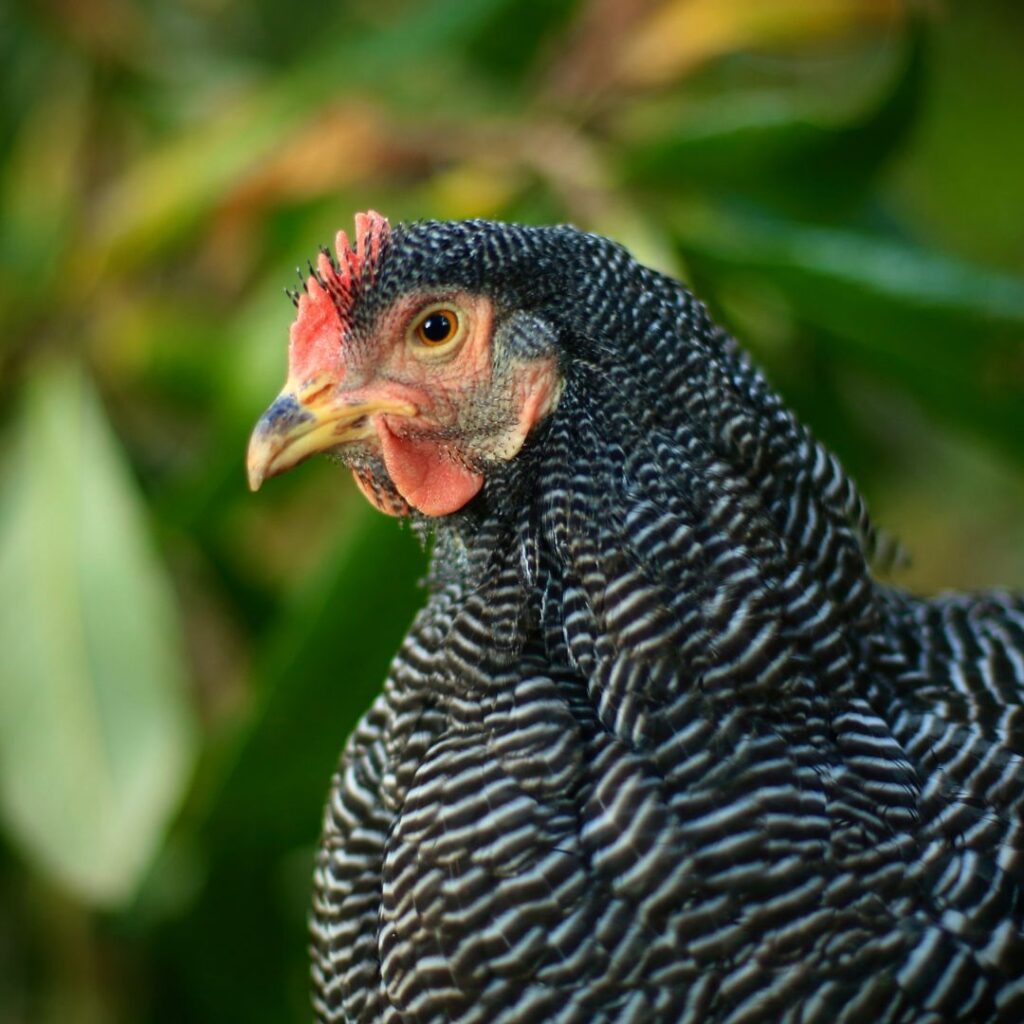
Barred Rocks or Plymouth Rock
Most people call these “Barred Rocks,” a short name for the Barred Plymouth Rock chicken.
These chickens get their name from the barring or streaks of black and white on their feathers.
Barred Plymouth Rock Appearance
Barred rock chickens are an average-sized breed of chicken, typically weighing in at around 7.5 pounds for females (hens) and 9.5 pounds for males (roosters).
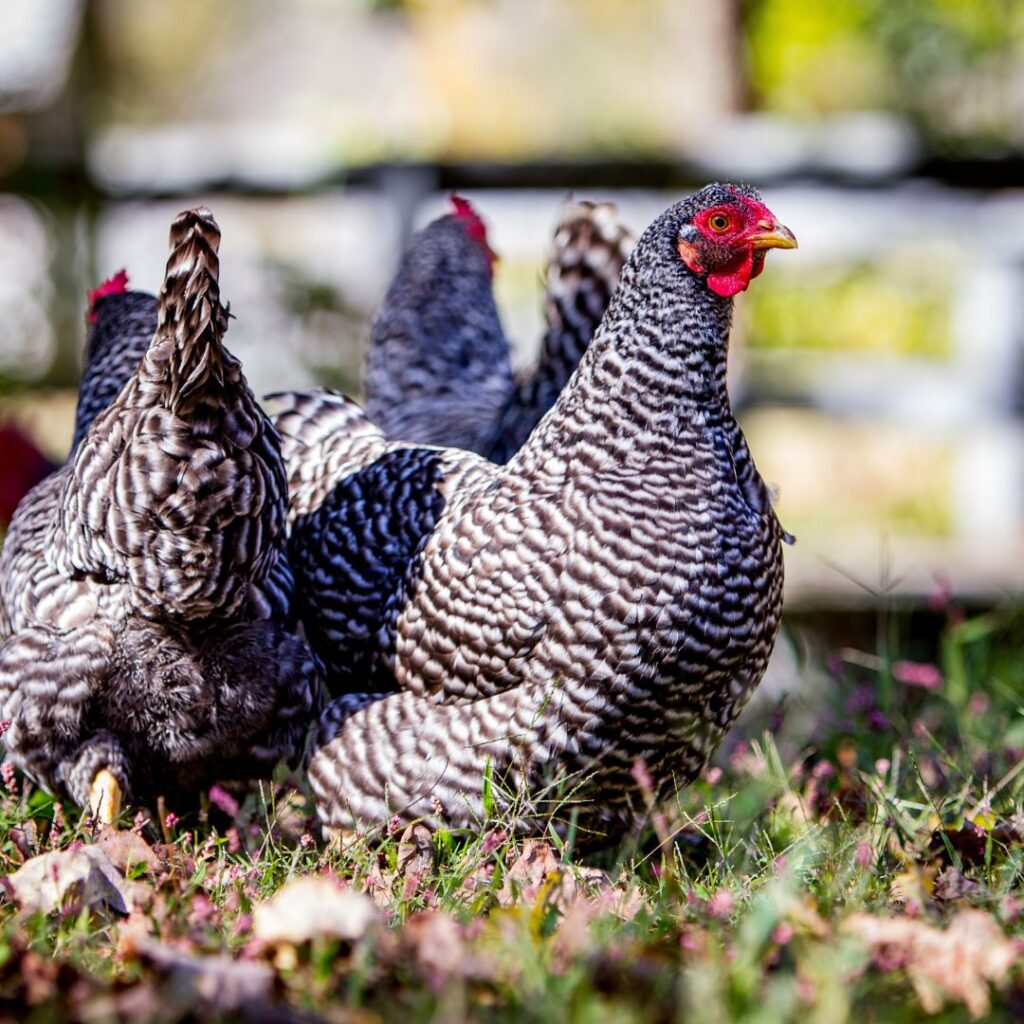
Breed Variations
Here, in the United States, seven color varieties of the Plymouth barred rock chicken are recognized (American Poultry Association):
Barred Plymouth Rock
Blue – These birds are the result of combining Barred Plymouth Rocks and Blue Andalusians, creating a production breed with sex-linked traits. Roosters and hens have a striking monochromatic gray color, with hens typically having lighter bodies and roosters featuring darker barring on their hackles and tails.
As chicks, they can range in color from nearly lavender to black. In addition to their stunning looks, Blue Rocks are also highly hardy and cold-tolerant.
This blue variety is commonly referred to as Plymouth Blues, Sapphire Blues, Sapphire Blue Rocks, Saphire Gems, and Sapphire Rocks.
Buff – If you’re looking for a showstopping bird in the poultry world, look no further than the Buff Rocks. They will turn heads at any exhibition with their stunning buff and gold feathers, vibrant red comb, and wattles. Even the baby chicks are born with fluffy golden down.
And it’s not just their appearance that makes them stand out – Buff Rocks are also known for their hardiness and adaptability in various climates, mothering skills, and tasty meat. Even the baby chicks are born with fluffy golden down.
Columbian – A relatively new variety of chicken that boasts striking plumage. Black feathers accent the mostly-white feathers on the neck with a narrow band of white, and the tail feathers have black lacing on the upper feathers.
Partridge – The Partridge Rock Hen is a beautiful bird with a reddish-brown base color and patches of black along its back, breast, and body. Their necks have coppery coloring reminiscent of the partridge, hence their namesake. Roosters are also stunning, with redheads and upper backs contrasted against glossy black feathers on their breasts and tail. Both hens and roosters have a single comb and slate or yellow legs.
Silver-penciled – These lovely birds have a field of white feathers with elegant black penciling, resembling silver-laced plumage. Their rare and beautiful appearance makes them highly prized for exhibition, and their valuable feathers are ideal for fly tying.
Male Silver Penciled Rocks have a silvery neck and back with a black breast, while females are covered in distinct silvery gray and black penciling.
It’s important to note that these birds have single combs, making them relatively low maintenance in terms of grooming requirements.
Overall, Silver Penciled Rocks make a stunning addition to any flock.
White – These birds are visually similar to Barred Rocks, but with one significant difference – they are entirely white.
Their fuzz can range from white to dark smoky shades as chicks, but they will eventually grow into their striking white feathers as juveniles. White Rocks have yellow legs as adults, though some may have darker leg coloring when younger. Their combs start yellow and will turn red as they mature and begin laying eggs (which they do at a great rate!). Their beaks are also yellow, and their eyes boast a gorgeous orange-red hue.
All in all, the White Rock is a stunning addition to any flock.
What does a Barred Plymouth Rock Chick Look Like?
Barred Rock baby chicks are black and gray with some white patches on their head and body.
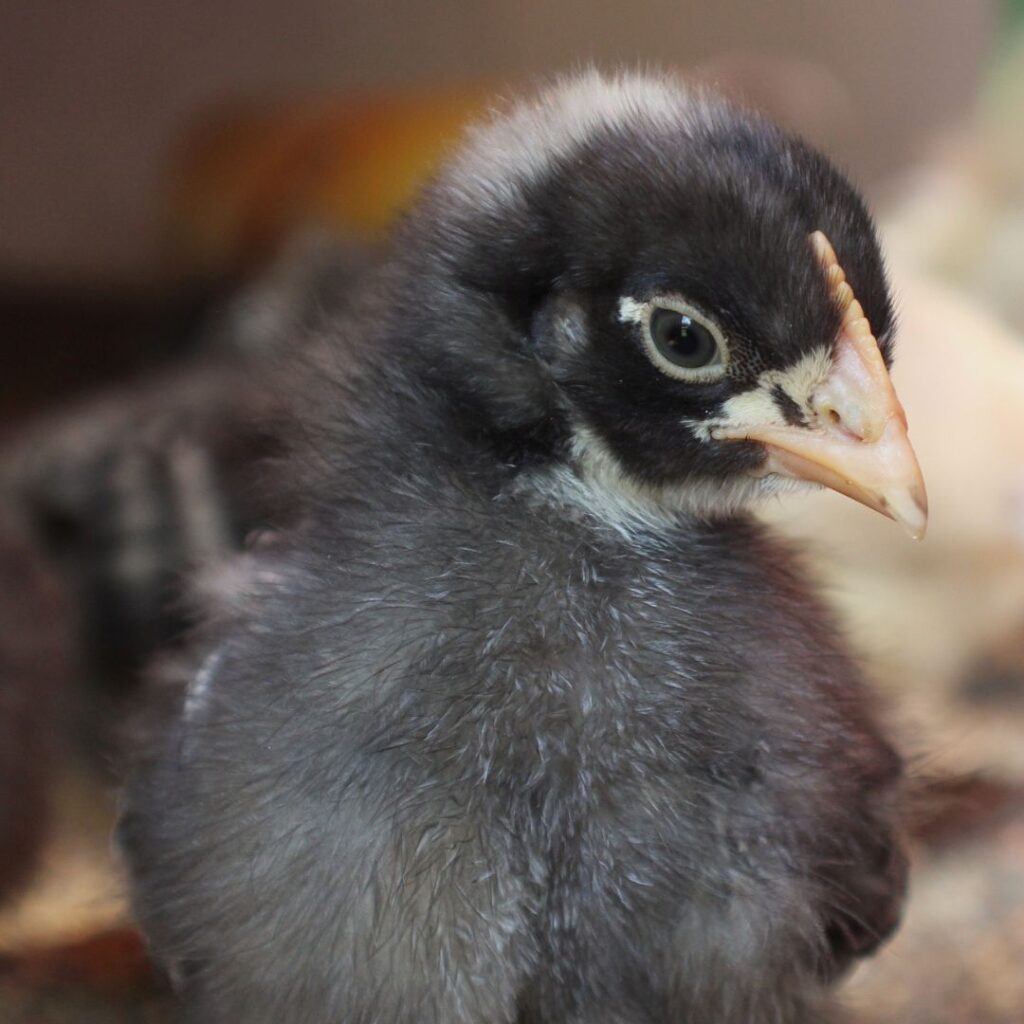
Barred Rock Personality
The barred rock is a friendly and docile bird that is not known to be mean or bad-tempered. These chickens suit backyard life well and easily integrate into a modest family setting. They are inquisitive and love to forage their food, a skill they are very adept at. They have a very unfussy demeanor and will be at home in confinement if they have sufficient space.
Are the Plymouth Rock Chickens Friendly?
Barred Rock chickens get along well with other breeds when kept in a flock. They are not aggressive birds and will happily live in harmony with other breeds. However, ensuring that the other breeds in your flock are friendly and not aggressive towards the Barred Rock chickens is essential.
Does The Barred Plymouth Rock Make a Good Family Pet?
The Barred Rock is a personable bird that is generally content to be handled and will tolerate the affections of young egg collectors. However, its disposition and personality make it a family-friendly choice for backyard poultry. Barred Rocks are friendly and curious and love interacting with people. They are also very active and playful, which makes them a lot of fun to watch. There are so many life lessons raising chickens can teach our kids; read more about how in this article here.
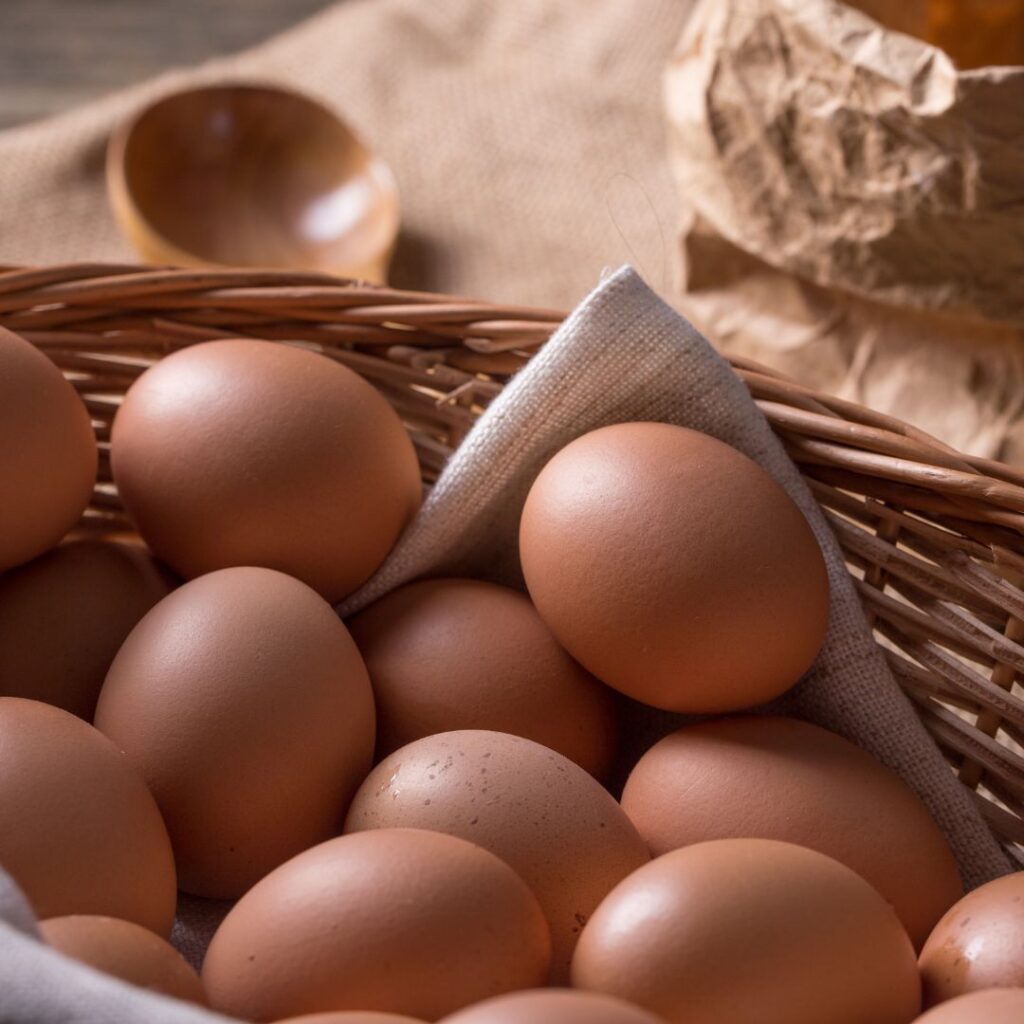
Barred Rock Hens; Egg Production
As both dependable layers and friendly companions, it’s no wonder that Barred Rock Hens have earned their reputation as reliable members of the chicken coop. They are prized for their high egg production and gentle temperament, making them a favorite bird for backyard chicken keepers.
When do Plymouth Rock Hens start laying eggs?
Plymouth Barred Rock Hens begin laying eggs at approximately 20 weeks old.
What color and egg size are Barred Rock Eggs?
The Plymouth rock hen lays large brown eggs,
How many large brown eggs do Barred Rocks Lay?
An average of 280-300 eggs per year. Barred Rocks tend to be reliable layers, producing a steady supply of large eggs and rarely taking breaks in their production.
Are Barred Rocks Dual Purpose Chickens?
The Plymouth Barred Rock is known for its meat and eggs as a dual-purpose chicken breed. Roosters weigh 9.5 pounds, making them an excellent choice for those looking to raise their table birds.
The breed’s popularity soared in the mid-1800s with homesteaders in New England, quickly becoming the most commonly bred chicken in the US. During World War II, Barred Rock’s meat and egg capabilities made it a valuable asset to both industries.
If you’re looking for a reliable bird that provides delicious meat and nutritious eggs, look no further than the Plymouth Barred Rock Hen or Rooster.
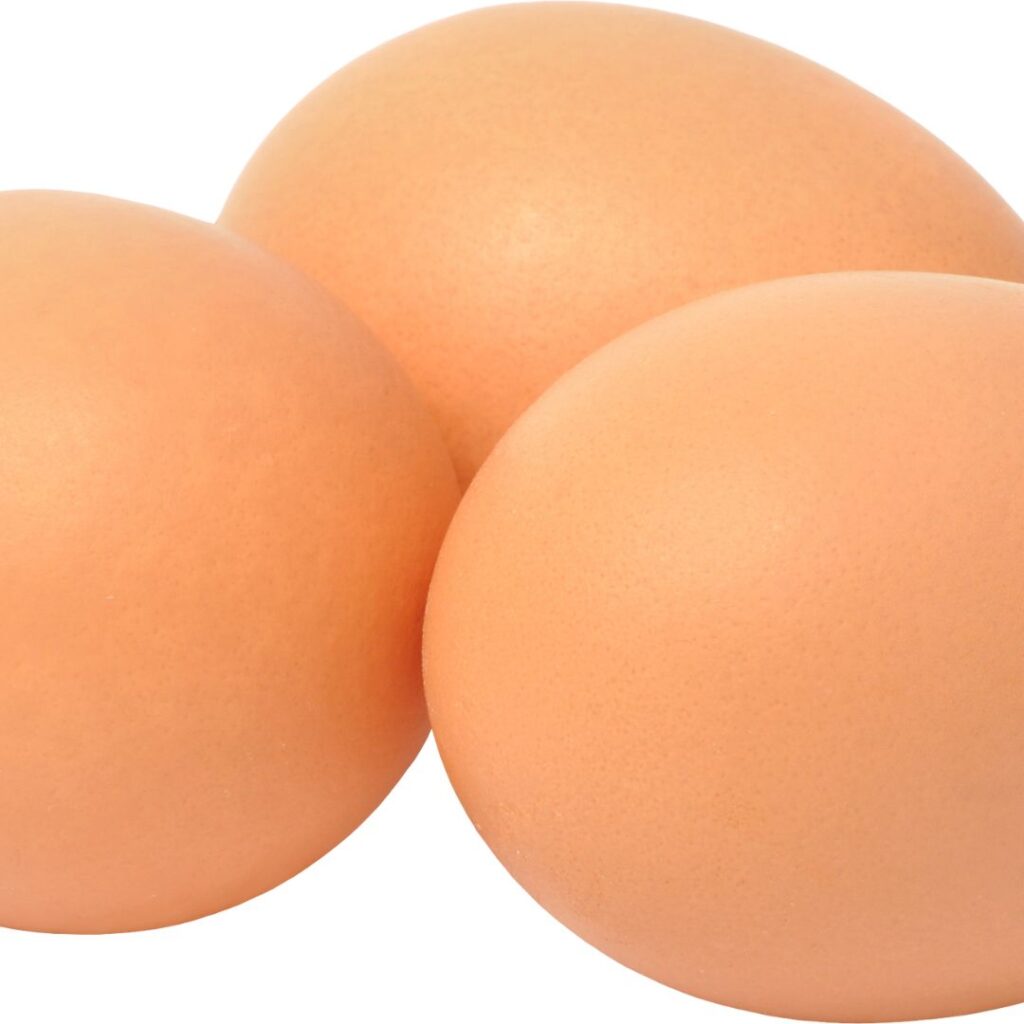
The Chicken Coop Size for Plymouth Rock Chickens
Space – A barred rock chicken coop should be about 10 square feet for each bird. This space will give them plenty of space to move around and get comfortable. You can either build your coop or purchase one that is already constructed. If you choose to build your own hen house, use weatherproof materials to keep the chickens warm in the winter and cool in the summer.
Perch – One of the most important things to consider when setting up a chicken coop is where to place the perches. The perches should be placed toward the coop’s back, away from nesting boxes, windows, and doors. This placement will ensure that the chickens stay out of harmful drafts and out of the nesting boxes at night. In addition, the perches should be secured to the coop’s walls and installed level.
To determine how many perches you need, count the chickens in your flock and then multiply that by 1 foot. Each chicken needs a minimum of 1 foot on the perch. However, providing more than the minimum is always best to keep your chickens comfortable. Also, never set roosts higher than 4 feet off the ground. When they are placed higher than this, the risk of injury increases, and following these simple guidelines ensures that your chickens have a safe and comfortable place to sleep.
Nesting box– Most chicken owners know that their birds need a nesting box to lay their eggs. A standard nest box for regular chickens such as Leghorns, Sussex, Plymouth Rocks, and hybrid layers must be a 12-inch cube, 12 inches tall, wide and deep. The size of your flock determines how many nesting boxes you’ll need, but a good rule of thumb is one box per four hens. This should give your ladies plenty of space to lay their eggs and ensure they’re comfortable. They’ll look elsewhere to lay eggs if they are uncomfortable in the nesting box. Be sure to change the bedding regularly to keep it fresh and reduce egg breakage. Following these simple guidelines, you can provide your chickens with the perfect environment for laying eggs.
The Chicken Run For Your Barred Plymouth Rock
Space– Chickens are social creatures that enjoy being outdoors, so you must consider their needs when deciding how much space to provide. For heavy breeds, like Barred Rocks or Buff Orpingtons, you should plan for at least 10 square feet of outdoor space per chicken. But really, the more space you can provide, the happier your chickens will be. If you let your chickens out to forage (free range) during the day, the run space can be less. By taking the time to plan and provide your chickens with a comfortable home, you’ll ensure that they’re happy and healthy – and that your investment pays off in delicious eggs!
Shelter from elements – You’ll want to provide an outdoor space in your run that allows your chickens to still go outside in all kinds of weather. This means a tarped or lean-to area for shade from the hot sun and cover from rain and snow. Winter runs should be shoveled for a spot for your birds to move around and get to their sheltered area.
Fencing – When it comes to fencing height for a chicken run, there are a few things to consider. The most important factor is keeping your chickens safe from predators. You’ll want to ensure the fence is tall enough that no predator can reach over and snatch a chicken. The other consideration is how high the fence needs to be so the chickens can’t fly out. A general guideline for fencing height for a chicken run is six feet. This will keep your chickens safe from predators and prevent them from escaping.
Dust Bath – Dust baths are essential for chickens because they help keep them clean and healthy. Chickens use dust baths to eliminate parasites and mites and keep their feathers clean and in good condition. A dust bath area should be a part of every chicken coop and be filled with non-toxic materials.
The health benefits of dust baths are many. Dust baths help keep chickens free from parasites and mites, which can cause problems like feather loss, skin irritation, and even death. Dust baths also help keep chickens’ feathers clean and in good condition, which can help them stay warm in the winter. And finally, dust baths are just plain fun for chickens! They enjoy rolling around in the dust, a great way to relax and have fun.
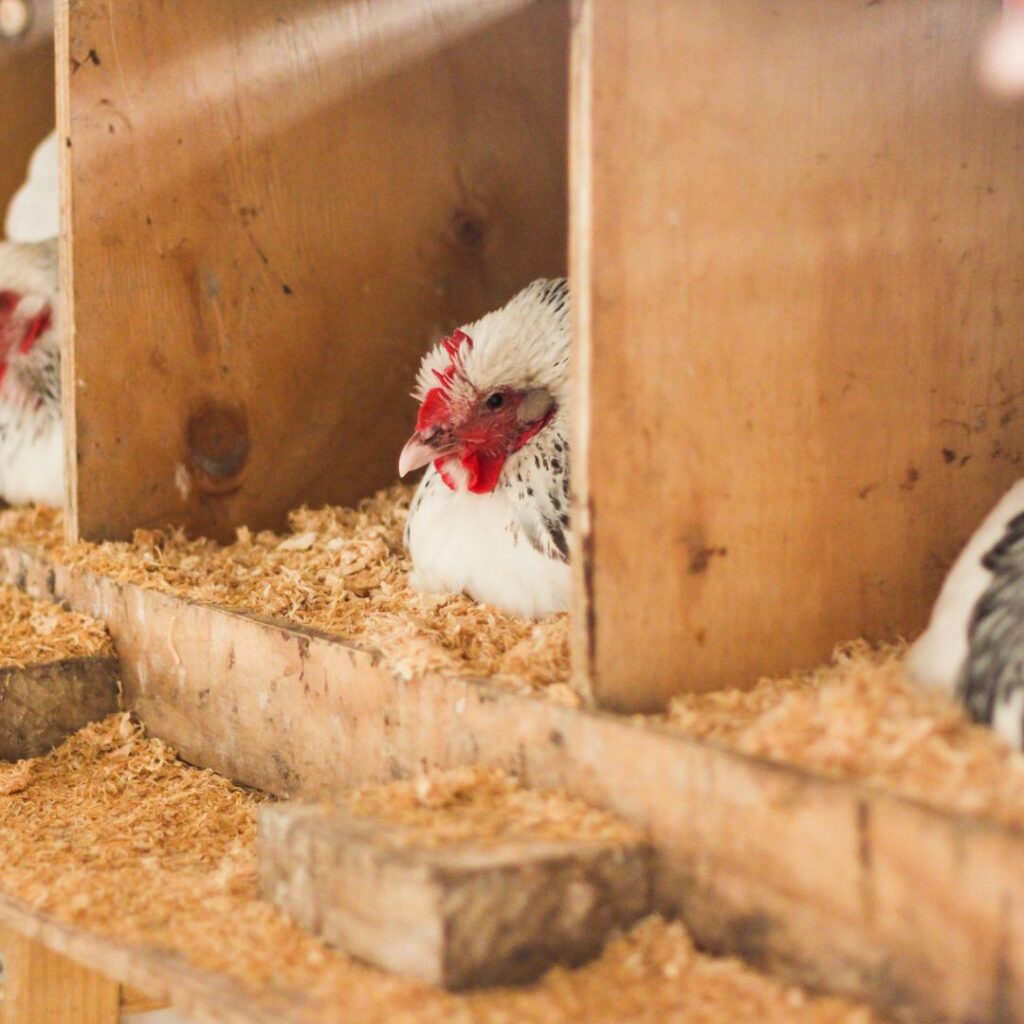
Free-Range and Foraging For The Barred Rocks
Plymouth Barred Rocks are active birds and will enjoy having room to roam and forage. If you have the space, consider letting them free-range in your yard or garden. Just supervise them, as they may dig up your plants!
Are the Plymouth Rock Good Urban (City) Chickens?
As urban and suburban hobby farmers know, noise levels can concern happy hens and their human neighbors. Plymouth Rocks are among the top quiet chicken breeds, making them an excellent choice for city and suburban flocks.
In addition to their quiet demeanor, Plymouth Rocks have many other favorable qualities. They get along well with humans, forage efficiently, and can tolerate confinement. They are also hardy birds that can handle extreme temperatures. Overall, Plymouth Rock is a fantastic all-around choice for any backyard coop.

Are Plymouth Rock Chickens Noisy?
Fortunately, Plymouth Rock chickens are known to be relatively quiet birds. While some may indulge in a bit of “hen chatter,” they typically don’t make much more noise than other breeds.
While they can be chatty at certain times, such as during egg-laying, they aren’t known for being particularly loud compared to other breeds. Of course, they may become a bit noisy, as with any hen during the egg-laying season.
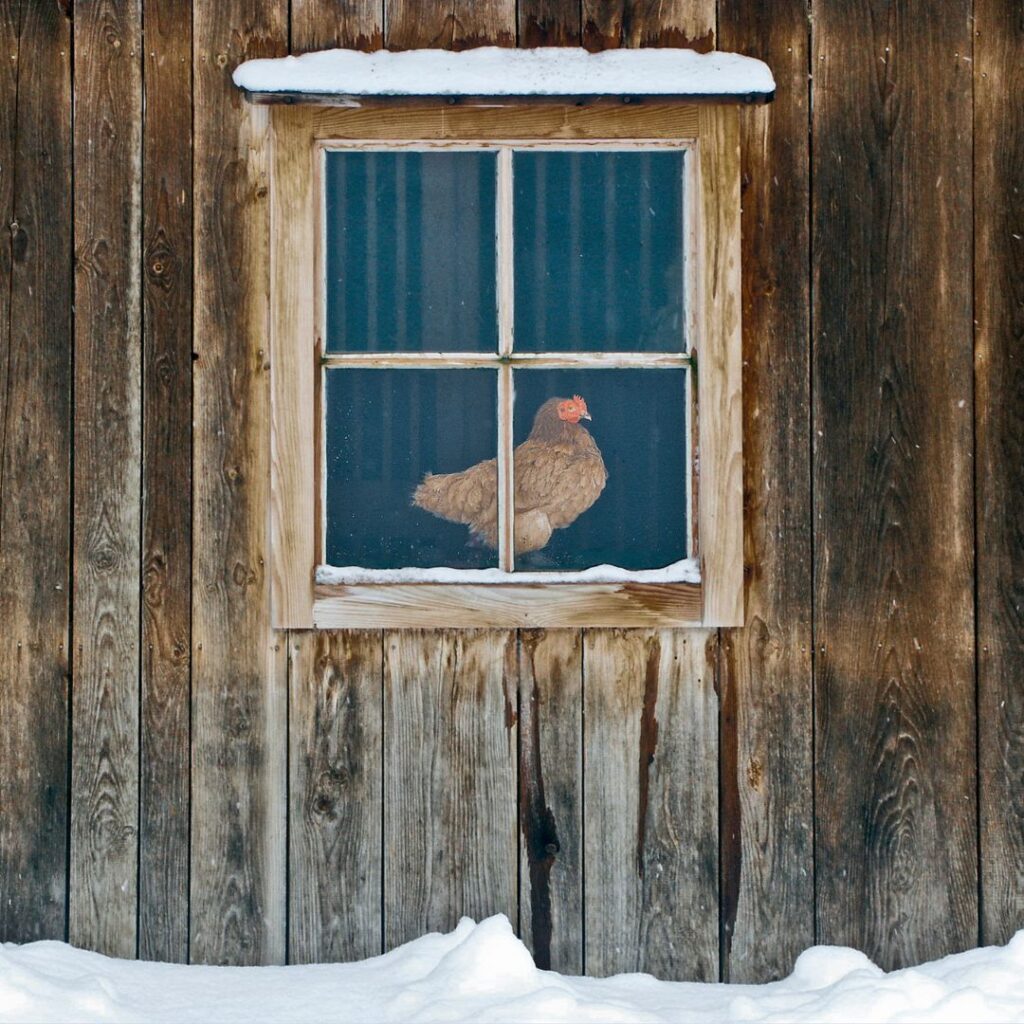
Are Barred Plymouth Rock Chickens Cold Hardy
Barred Rock hens are known for their cold hardiness, but the same cannot be said of their roosters. Because Barred Rock roosters have large combs and wattles, they are prone to frostbite. As a result, they will need extra protection from the cold in the winter. The best way to keep them warm and dry is to provide a secure coop area. These preparation steps will help to protect them from the elements and allow them to stay warm throughout the winter months.
Coop Prep
When preparing a chicken coop for winter, there are a few key things to remember. The first is insulation. Chickens need a draft-free environment with plenty of insulation to stay warm. In addition, you will need to make sure the coop is well-ventilated to prevent moisture build-up. Another important consideration is food and water. Chickens will need access to food and water at all times, especially in cold weather when they burn more calories. Finally, ensure your chickens have a place to roost protected from the elements.
Waterers and Feeders – Winter can be challenging for chicken keepers. You can provide water more frequently to your flock. Bringing water often assures a fresh ‘non-frozen’ water source. You could invest in a heated waterer or bowl warmer. While these are a bit pricey, they are a worthwhile expense for many, especially if you are busy or working and can’t change water throughout the day.
Frostbite – Frostbite can be a problem for chickens with large combs. With the Barred Rock, the roosters are at the highest risk. Frostbite is extremely painful and can lead to further problems with your flock. Fortunately, most hobby farmers and chicken keepers have fewer roosters than hens. Many flock owners use petroleum jelly to help protect their chickens.
Run Prep – Chicken runs should be shoveled, allowing your flock to get out and about for a time during the day. You can prepare by having an area covered in the run to shelter the birds from rain and snow. Chickens aren’t bothered by snow on the ground as much as they have it fall on their feathers. Wet birds can lead to frostbite and decreased body temperatures. Winters are about giving your chickens optimal conditions to stay dry so their bodies can maintain heat.
Treats – Warm-weather treats can be cooked grains and cooked oatmeal with fruits added. Your Barred Plymouth Rocks also love warm apple sauce, cooked fruits, and vegetables like mashed carrots and yams. Remember, 10% of daily feed should be the maximum for treats.
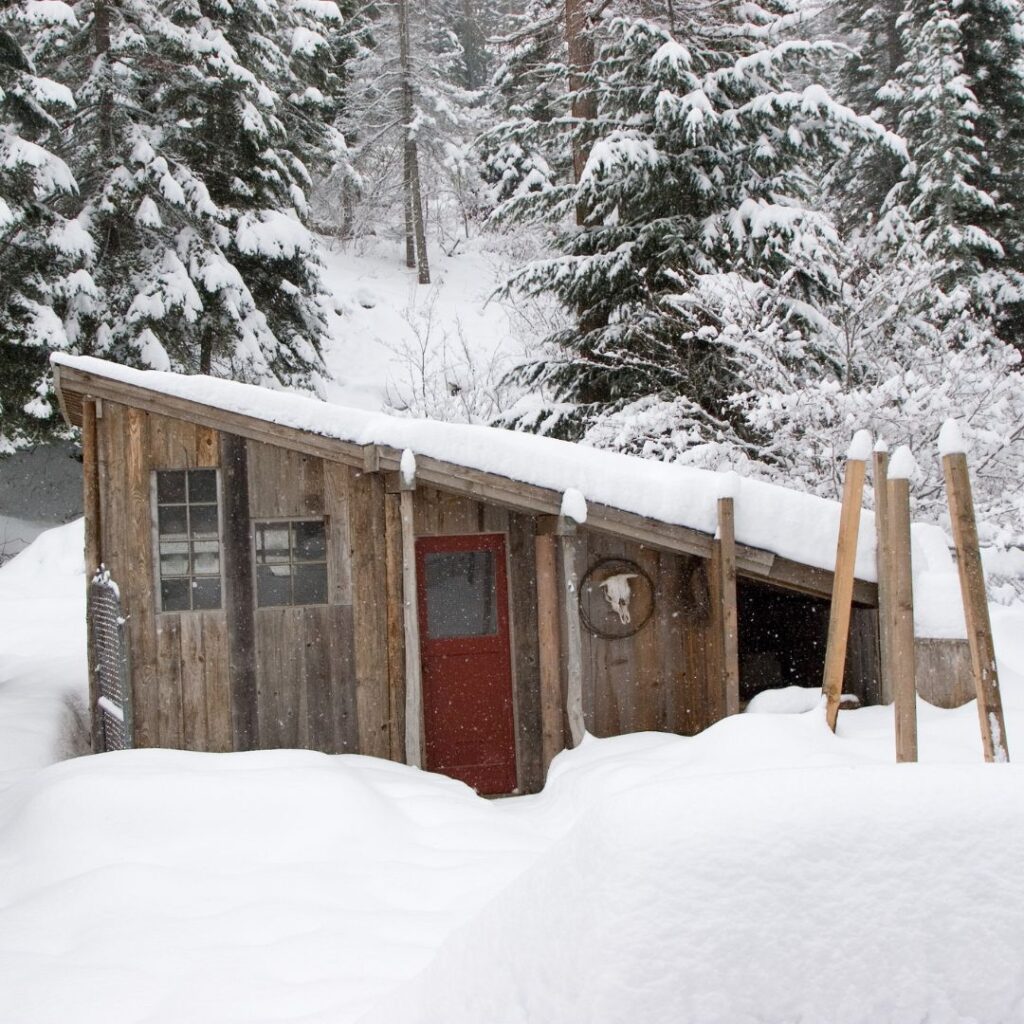
Are Barred Rock Chickens Heat Tolerant
The Barred Plymouth Rock is a heat-tolerant chicken that can easily withstand temperatures up to 95 degrees Fahrenheit. They are ideal for climates with a spring-like atmosphere, with temperatures around 70 degrees Fahrenheit. However, they can do well in much warmer climates with proper shade and a freshwater source.
Coop Prep – When preparing your chicken coop for hot weather, ensure that your chickens have plenty of shade and ventilation. You can provide shade by adding a canopy or pergola to your coop or planting trees nearby. You can provide ventilation with exhaust fans in your coop. However, a less expensive option is to keep coop doors open while keeping them secure. Installing screen doors are a great way to do this. You will also want to ensure that your chickens have plenty of water to drink and that their bedding is dry.
Run Prep – Surprisingly run prep is similar to winter in providing shelter. In hot weather, the sheltered area protects from rain and provides shade. If you can, put a tarp or shade cloth closer to the coop, and this may aid in reducing the inside coop temperature.
Waterers and Feeders – Water should be cool and fresh at all times. A great way to do this is to add ice cubes to the waterers and even put a bowl of ice out as extra assurance. As it melts, the chickens can wet their beaks and get a drink.
Treats – Frozen treats are great fun for chickens. Not only does it cool them off, but they also entertain trying to peck to get the treat in the ice.
Consider placing some kitchen of garden fruit n veggie scraps in a pot of water and freezing, then place a giant ice cube out for your flock to enjoy.
Life Expectancy of the Barred Plymouth Rock
A typical Barred Plymouth Rock chicken’s lifespan is around 6-8 years, though some have been known to live up to 10-12 with proper care and living conditions.
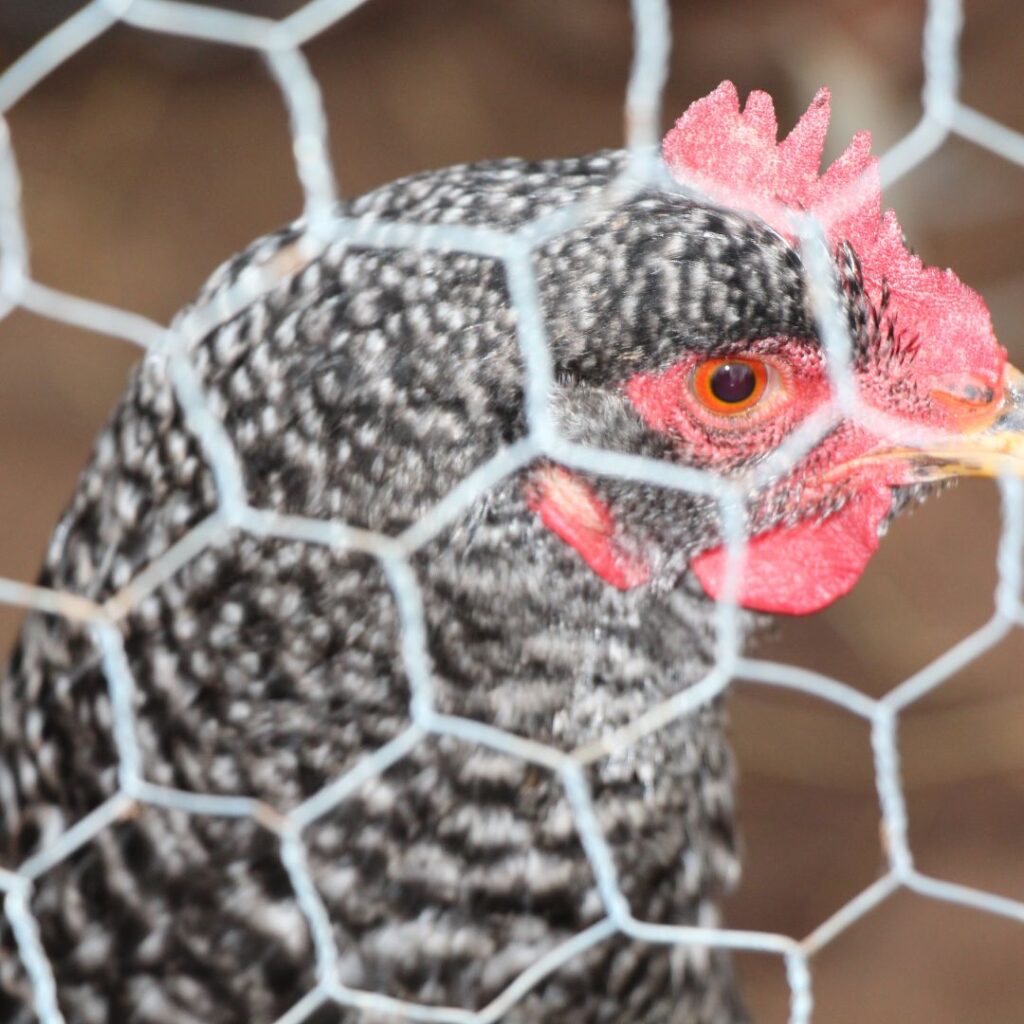
Is The Barred Plymouth Rock Right For Backyard Chicken Lovers?
The Barred Plymouth Rock might be the perfect choice for backyard chicken lovers. These chickens make for easy and enjoyable companions with their large, tasty eggs and gentle, sweet-natured personalities. They get along well with other animals, making them suitable for any mixed household. Plus, their quiet nature means they can thrive in both urban and rural environments. And on top of all that, Plymouth Rocks are hardy birds with impressive health and resistance to cold temperatures. Overall, these chickens have it all – and make an excellent addition to any backyard flock and hobby farm.




Pingback: French Black Copper Marans Chicken, About Eggs, Care, History
Pingback: What chickens can Teach Children, A Great Pet Choice - Gilmore's
Pingback: 15+ Best Egg Laying Chicken Breeds; Qty, Color, Size Of Eggs
Pingback: Speckled Sussex Chickens; Is This Breed Right For You?
Pingback: Cream Legbar Chickens: About The Breed And Its Needs
Pingback: Cornish Chickens: A sweet Heritage Breed - Gilmore's
Pingback: Golden Laced Wyandotte Chicken; About The Wyandotte Chicken Breed
Pingback: The Black Star Chicken; About Black Sex Links & Sex Link Chickens